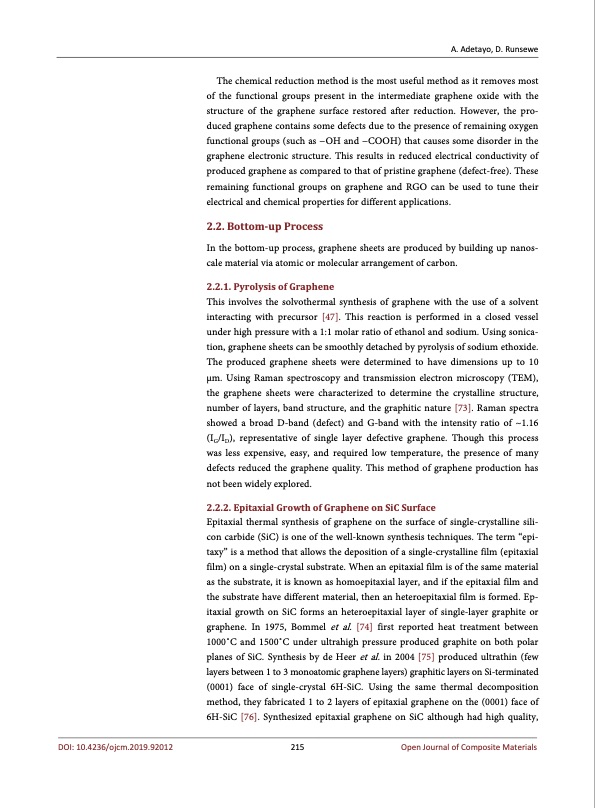
PDF Publication Title:
Text from PDF Page: 009
A. Adetayo, D. Runsewe The chemical reduction method is the most useful method as it removes most of the functional groups present in the intermediate graphene oxide with the structure of the graphene surface restored after reduction. However, the pro- duced graphene contains some defects due to the presence of remaining oxygen functional groups (such as −OH and −COOH) that causes some disorder in the graphene electronic structure. This results in reduced electrical conductivity of produced graphene as compared to that of pristine graphene (defect-free). These remaining functional groups on graphene and RGO can be used to tune their electrical and chemical properties for different applications. 2.2. Bottom-up Process In the bottom-up process, graphene sheets are produced by building up nanos- cale material via atomic or molecular arrangement of carbon. 2.2.1. Pyrolysis of Graphene This involves the solvothermal synthesis of graphene with the use of a solvent interacting with precursor [47]. This reaction is performed in a closed vessel under high pressure with a 1:1 molar ratio of ethanol and sodium. Using sonica- tion, graphene sheets can be smoothly detached by pyrolysis of sodium ethoxide. The produced graphene sheets were determined to have dimensions up to 10 μm. Using Raman spectroscopy and transmission electron microscopy (TEM), the graphene sheets were characterized to determine the crystalline structure, number of layers, band structure, and the graphitic nature [73]. Raman spectra showed a broad D-band (defect) and G-band with the intensity ratio of ~1.16 (IG/ID), representative of single layer defective graphene. Though this process was less expensive, easy, and required low temperature, the presence of many defects reduced the graphene quality. This method of graphene production has not been widely explored. 2.2.2. Epitaxial Growth of Graphene on SiC Surface Epitaxial thermal synthesis of graphene on the surface of single-crystalline sili- con carbide (SiC) is one of the well-known synthesis techniques. The term “epi- taxy” is a method that allows the deposition of a single-crystalline film (epitaxial film) on a single-crystal substrate. When an epitaxial film is of the same material as the substrate, it is known as homoepitaxial layer, and if the epitaxial film and the substrate have different material, then an heteroepitaxial film is formed. Ep- itaxial growth on SiC forms an heteroepitaxial layer of single-layer graphite or graphene. In 1975, Bommel et al. [74] first reported heat treatment between 1000 ̊C and 1500 ̊C under ultrahigh pressure produced graphite on both polar planes of SiC. Synthesis by de Heer et al. in 2004 [75] produced ultrathin (few layers between 1 to 3 monoatomic graphene layers) graphitic layers on Si-terminated (0001) face of single-crystal 6H-SiC. Using the same thermal decomposition method, they fabricated 1 to 2 layers of epitaxial graphene on the (0001) face of 6H-SiC [76]. Synthesized epitaxial graphene on SiC although had high quality, DOI: 10.4236/ojcm.2019.92012 215 Open Journal of Composite MaterialsPDF Image | Synthesis and Fabrication of Graphene and Graphene Oxide

PDF Search Title:
Synthesis and Fabrication of Graphene and Graphene OxideOriginal File Name Searched:
OJCM-2019042814574897.pdfDIY PDF Search: Google It | Yahoo | Bing
Salgenx Redox Flow Battery Technology: Power up your energy storage game with Salgenx Salt Water Battery. With its advanced technology, the flow battery provides reliable, scalable, and sustainable energy storage for utility-scale projects. Upgrade to a Salgenx flow battery today and take control of your energy future.
| CONTACT TEL: 608-238-6001 Email: greg@infinityturbine.com | RSS | AMP |